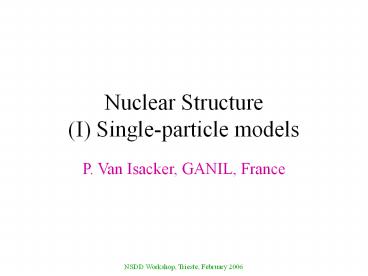Nuclear Structure (I) Single-particle models - PowerPoint PPT Presentation
Title:
Nuclear Structure (I) Single-particle models
Description:
Nuclear Structure (I) Single-particle models P. Van Isacker, GANIL, France Overview of nuclear models Ab initio methods: Description of nuclei starting from the bare ... – PowerPoint PPT presentation
Number of Views:130
Avg rating:3.0/5.0
Title: Nuclear Structure (I) Single-particle models
1
Nuclear Structure(I) Single-particle models
- P. Van Isacker, GANIL, France
2
Overview of nuclear models
- Ab initio methods Description of nuclei starting
from the bare nn nnn interactions. - Nuclear shell model Nuclear average potential
(residual) interaction between nucleons. - Mean-field methods Nuclear average potential
with global parametrisation ( correlations). - Phenomenological models Specific nuclei or
properties with local parametrisation.
3
Nuclear shell model
- Many-body quantum mechanical problem
- Independent-particle assumption. Choose V and
neglect residual interaction
4
Independent-particle shell model
- Solution for one particle
- Solution for many particles
5
Independent-particle shell model
- Anti-symmetric solution for many particles
(Slater determinant) - Example for A2 particles
6
Hartree-Fock approximation
- Vary ?i (ie V) to minize the expectation value of
H in a Slater determinant - Application requires choice of H. Many global
parametrizations (Skyrme, Gogny,) have been
developed.
7
Poor mans Hartree-Fock
- Choose a simple, analytically solvable V that
approximates the microscopic HF potential - Contains
- Harmonic oscillator potential with constant ?.
- Spin-orbit term with strength ?.
- Orbit-orbit term with strength ?.
- Adjust ?, ? and ? to best reproduce HF.
8
Harmonic oscillator solution
- Energy eigenvalues of the harmonic oscillator
9
Energy levels of harmonic oscillator
- Typical parameter values
- Magic numbers at 2, 8, 20, 28, 50, 82, 126,
184,
10
Why an orbit-orbit term?
- Nuclear mean field is close to Woods-Saxon
- 2nlN degeneracy is lifted ? El lt El-2 lt ?
11
Why a spin-orbit term?
- Relativistic origin (ie Dirac equation).
- From general invariance principles
- Spin-orbit term is surface peaked ? diminishes
for diffuse potentials.
12
Evidence for shell structure
- Evidence for nuclear shell structure from
- 2 in even-even nuclei Ex, B(E2).
- Nucleon-separation energies nuclear masses.
- Nuclear level densities.
- Reaction cross sections.
- Is nuclear shell structure
modified away from the
line of stability?
13
Ionisation potential in atoms
14
Neutron separation energies
15
Proton separation energies
16
Liquid-drop mass formula
- Binding energy of an atomic nucleus
- For 2149 nuclei (N,Z 8) in AME03
- avol?16, asur?18, acou?0.71, asym?23, apai?13
- ? ?rms?2.93 MeV.
C.F. von Weizsäcker, Z. Phys. 96 (1935) 431 H.A.
Bethe R.F. Bacher, Rev. Mod. Phys. 8 (1936) 82
17
Deviations from LDM
18
Modified liquid-drop formula
- Add surface, Wigner and shell corrections
- For 2149 nuclei (N,Z 8) in AME03
- avol?16, asur?18, acou?0.72, avsym?32,
assym?79, apai?12, af?0.14, aff?0.0049, r?2.5 - ? ?rms?1.28 MeV.
19
Deviations from modified LDM
20
(No Transcript)
21
Shell structure from Ex(21)
22
Evidence for IP shell model
- Ground-state spins and parities of nuclei
23
Validity of SM wave functions
- Example Elastic electron scattering on 206Pb and
205Tl, differing by a 3s proton. - Measured ratio agrees with shell-model prediction
for 3s orbit.
J.M. Cavedon et al., Phys. Rev. Lett. 49 (1982)
978
24
Variable shell structure
25
Beyond Hartree-Fock
- Hartree-Fock-Bogoliubov (HFB) Includes pairing
correlations in mean-field treatment. - Tamm-Dancoff approximation (TDA)
- Ground state closed-shell HF configuration
- Excited states mixed 1p-1h configurations
- Random-phase approximation (RPA) Cor-relations
in the ground state by treating it on the same
footing as 1p-1h excitations.
26
Nuclear shell model
- The full shell-model hamiltonian
- Valence nucleons Neutrons or protons that are in
excess of the last, completely filled shell. - Usual approximation Consider the residual
interaction VRI among valence nucleons only. - Sometimes Include selected core excitations
(intruder states).
27
Residual shell-model interaction
- Four approaches
- Effective Derive from free nn interaction taking
account of the nuclear medium. - Empirical Adjust matrix elements of residual
interaction to data. Examples p, sd and pf
shells. - Effective-empirical Effective interaction with
some adjusted (monopole) matrix elements. - Schematic Assume a simple spatial form and
calculate its matrix elements in a
harmonic-oscillator basis. Example ? interaction.
28
Schematic short-range interaction
- Delta interaction in harmonic-oscillator basis
- Example of 42Sc21 (1 neutron 1 proton)
29
Large-scale shell model
- Large Hilbert spaces
- Diagonalisation 109.
- Monte Carlo 1015.
- DMRG 10120 (?).
- Example 8n 8p in pfg9/2 (56Ni).
M. Honma et al., Phys. Rev. C 69 (2004) 034335
30
The three faces of the shell model
31
Racahs SU(2) pairing model
- Assume pairing interaction in a single-j shell
- Spectrum 210Pb
32
Solution of the pairing hamiltonian
- Analytic solution of pairing hamiltonian for
identical nucleons in a single-j shell - Seniority ? (number of nucleons not in pairs
coupled to J0) is a good quantum number. - Correlated ground-state solution (cf. BCS).
G. Racah, Phys. Rev. 63 (1943) 367
33
Nuclear superfluidity
- Ground states of pairing hamiltonian have the
following correlated character - Even-even nucleus (?0)
- Odd-mass nucleus (?1)
- Nuclear superfluidity leads to
- Constant energy of first 2 in even-even nuclei.
- Odd-even staggering in masses.
- Smooth variation of two-nucleon separation
energies with nucleon number. - Two-particle (2n or 2p) transfer enhancement.
34
Two-nucleon separation energies
- Two-nucleon separation energies S2n
- (a) Shell splitting dominates over interaction.
- (b) Interaction dominates over shell splitting.
- (c) S2n in tin isotopes.
35
Pairing gap in semi-magic nuclei
- Even-even nuclei
- Ground state ?0.
- First-excited state ?2.
- Pairing produces constant energy gap
- Example of Sn isotopes
36
Elliotts SU(3) model of rotation
- Harmonic oscillator mean field (no spin-orbit)
with residual interaction of quadrupole type
J.P. Elliott, Proc. Roy. Soc. A 245 (1958) 128
562































